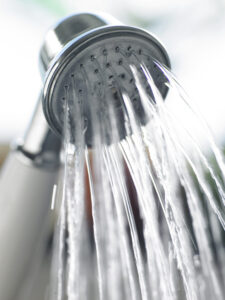
If you’re dealing with low water pressure at your home or business, there are a few potential culprits to look into.
Low water pressure can be a frustrating issue for homeowners, causing appliances and fixtures to work improperly. Water pressure is measured in pounds per square inch (PSI) and should typically range between 30 to 80 PSI, with an ideal range of 40 to 60 PSI. While high water pressure can damage plumbing fixtures, appliances, and pipes, low water pressure can also be problematic, resulting in ineffective cleaning of dishwashers and clothes washers, slow faucet fills, and weak showerheads.
In this homeowner’s guide to diagnosing your low water pressure problems, we’ll explore the causes and offer tips for troubleshooting this issue.
Your Valve is Partially Closed
Low water pressure can often be caused by partially closed shutoff valves obstructing the water flow. In most homes, there is a main shutoff valve located inside the house, near where the main water supply pipe enters the home. Some homes may also have a water meter valve, which can be located either indoors or outdoors in a utility box.
To troubleshoot low water pressure caused by shutoff valves, check each valve on the main water supply line for proper operation. If any valves are broken or leaking, hire a plumber to replace them, and then open each valve fully to restore water pressure.
There’s Debris in Your Pipes
Pipe blockages caused by debris, pollutants, or mineral buildup can significantly affect water pressure. Debris such as dirt, sand, solidified oil and grease, food particles, or foreign objects can easily clog pipes, while pollutants can cause blockages due to water main fractures. Mineral buildup over time can also reduce the space available for water to flow through, leading to lower water pressure.
To troubleshoot this issue, start by cleaning the faucet’s aerator to remove sediment. Follow the steps of removing and rinsing the aerator’s parts before reassembling it. Repeat this process with all your faucets. Then, flush the pipes by opening three to four faucets at full force for 20 minutes and turning on the outdoor hose for extra cleaning power.
You Have Corroded Water Lines
Low water pressure caused by corrosion is a serious and potentially expensive problem that occurs in older galvanized steel pipes. Over time, corrosion and scale buildup gradually restrict the flow of water through the pipe until it fails completely. This problem develops slowly, so you may not notice a sudden pressure drop. Re-piping the system with new copper or plastic water supply piping is the only solution for corroded pipes.
Your Pipes Are Leaking
Just one leak shouldn’t reduce your water pressure, though it could be an additional factor or you may have multiple leaks. If you find a leak, temporarily fix it by turning off your water supply, drying the outside of the leaky pipe, and wrapping a rubber patch around the damaged area. Then, use electrical tape and a pipe repair clamp to attach the rubber patch to the pipe. However, leaks can damage your foundation and contaminate your drinking water, so call a plumber to address the issue properly.
Your Pressure Regulator is Failing
Faulty pressure regulators or pressure-reducing valves are a common cause of low water pressure. A pressure regulator reduces the input pressure to a safe level, but a failing regulator can cause a sudden drop or spike in water pressure. To check if your regulator is at fault, attach a water pressure gauge to the outdoor hose spigot closest to the regulator or water main. If the pressure is low, it may indicate a failed regulator that needs replacement, which is not a quick fix.
Call Mahon Plumbing Today
If you still have more questions regarding your plumbing, we here at Mahon Plumbing are here to help. We have been serving the wider Baltimore area since 1994, so we have 25 years of experience to back up our fantastic service! Call us at our Baltimore location at 410-766-8566 or our Pasadena location at 410-636-7944. Be sure to keep up with us on social media by following us on Facebook or Twitter.
